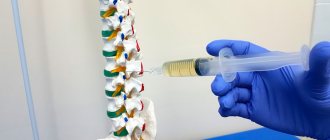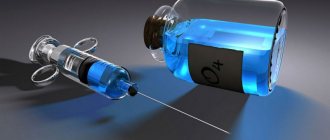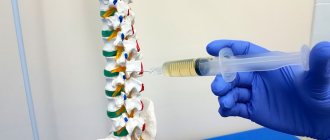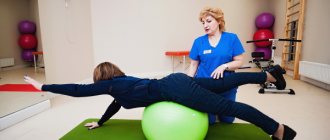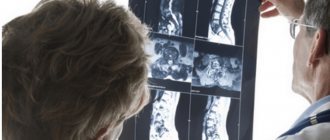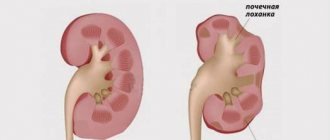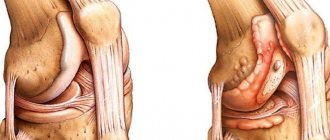The presence of back pain causes great inconvenience to a person’s life. The source of pain can be muscles, ligaments, intervertebral discs or vertebrae. Pain can be caused by excessive muscle strain, excessive stress, or injury (at home, at work, or while playing sports). Ignoring pain or self-medicating can only aggravate the situation and provoke a disease that can subsequently lead to paralysis.
The appearance of back pain can be affected by prolonged and incorrect body position (working posture at a computer desk, incorrect position in the driver's seat), incorrect posture, metabolic disorders, the presence of rheumatic diseases and stress.
Blockade for back pain: advantages and disadvantages
A blockade is a procedure that allows you to turn off the transmission of a nerve or pain impulse - to block a nerve. The blockade is carried out by injecting medication to the site of the inflamed nerve root.
Among the advantages of the blockade, the speed of the body's response should be noted. The result comes in 10-15 minutes. The patient begins to feel relief almost immediately. The pain decreases and then goes away completely. The effect of blockade treatment lasts up to 5-7 days.
After administration of the drug, a decrease in swelling, restoration of blood circulation and elimination of muscle spasms are observed. There are practically no side effects. The only drawback is the injection itself.
According to modern recommendations, it is advisable to carry out a course of blockades at intervals of 3-5 days.
List of popular medications used for blockades
Local anesthetics are used for simple pain relief. The most commonly used is 2% Novocaine. The inexpensive drug is well tolerated by most patients and rarely causes adverse reactions. The analgesic effect occurs after a few minutes and lasts up to 2 hours.
Lidocaine solution is no less popular for local administration. Like Novocaine, the drug has a rapid analgesic effect and allows you to relieve acute pain. The only contraindication for use is intolerance to Lidocaine.
Marcaine is rarely used to relieve pain. The medicine allows the patient to be relieved of pain for 5-6 hours, but the medicine is prohibited for people with vascular or heart diseases, so the person must be examined before use. After the administration of Marcaine, the analgesic effect occurs only after 20 minutes.
In neurology, therapeutic analgesic blockades are often carried out when anesthetics are mixed with hormonal agents:
- Prednisolone;
- Hydrocortisone;
- Diprospan;
- Kenalog.
According to doctors, the use of Novocaine or Lidocaine with hormonal drugs or NSAIDs can quickly alleviate the patient’s condition. Local administration of drugs makes it possible to act on the affected area, reducing inflammation of the cartilage and stimulating tissue regeneration. Therapeutic blockades can be prescribed for moderate pain.
Injection into the spine: types of blockades
Based on the type of drugs used, the following types of blockades are distinguished:
- Anti-inflammatory or hormonal blockade of the spine. Corticosteroids are used in injections. With their help, it is possible to relieve inflammation in 1-2 visits to the doctor.
- Painkiller blockades. For example, novocaine blockade for spinal hernia. Lidocaine, marcaine and other anesthetics are also used for these purposes.
- Mixed. In 90% of cases, the doctor uses several drugs to achieve maximum effect.
Anesthetic blockade of the spine according to the technique of the procedure is divided into:
- Paravertebral. With this type of procedure, in addition to nerve blockade, a back muscle block is performed.
- Transforaminal. The doctor makes an injection at the point where the nerves exit the intervertebral foramina. This type of blockade is used very rarely.
|
|
Sign up for treatment
Classification of blockades
Medicines may be injected into the lumbar canal, bone, joint, or soft tissue surrounding the compressed nerve roots. How the blockade will be carried out is selected by the neurologist individually, taking into account the characteristics of the protrusion and accompanying symptoms. When choosing a technique, the following are taken into account: the direction of the cartilaginous protrusion, the direction of the vertebral displacement and the severity of muscle spasms.
There are several types of this procedure:
- Paravertebral. An anesthetic is placed in the soft tissue near the spine to eliminate pain when the nerve is compressed.
- Epidural. Medicines are injected into the spinal membranes.
- Intra-articular. Injection of drugs into the spinal joint for pain relief is rarely done. Typically, this procedure is used to stimulate the regeneration of cartilage tissue in case of destructive changes in the disc.
- Paraarticular. Medicines are placed in the paravertebral muscles, ligaments and tendons.
In addition to injections into the spinal canal or surrounding tissues, for severe pain and myospasms, injections are given in the area of trigger points. This allows you to quickly relieve painful manifestations during protrusion.
How to do back blockades
To perform a paravertebral block, it is necessary to place the patient on his stomach, after which the location of maximum pain is determined. Stepping back from the midline of the spine to the width of two fingers, after preliminary anesthesia, the drug is injected to a depth of 4-5 cm. To achieve the desired effect, 3-6 injections are required. The effect of the administered substance lasts up to 2-3 weeks.
Orthopedic doctor Andrey Sergeevich Litvinenko comments:
A more complex procedure is the transforaminal type of blockade. To carry it out, a contrast agent must be injected, and the manipulation itself must be carried out under X-ray control or with a fluoroscope. There are cases when after the blockade the pain does not go away. There can be quite a lot of reasons for this. To resolve this issue, you must definitely contact a specialist.
You can find out the price of back blockades or blockades for lower back pain and make an appointment directly on our website.
What to do after the pain disappears
Once your lower back has stopped hurting, you don’t need to consider yourself recovered. Local application of anesthetics alleviates the condition, but does not cure the disease. After the blockade, strict bed rest is required for 2-3 hours.
Patients should remember to move carefully, avoiding sudden movements in the lower back. Failure to comply with these rules will lead to repeated displacement of the vertebra and the development of complications.
Treatment of protrusion occurs slowly and it is important to follow all the doctor’s instructions: during the acute stage, maintain therapeutic rest and take prescribed medications. And when the disease passes into a subacute form, do not neglect performing exercise therapy and attend physical procedures. Complex therapy will partially restore damaged cartilage and reduce the likelihood of pain reoccurring.
Treatment at the Stoparthrosis clinic: Blockade for pain in the spine
Before performing the blockade, specialists from the Stoparthrosis clinic will conduct an examination. This will help establish a diagnosis and select the most suitable drugs for back blockade. Don't endure pain, but enjoy a full life. We are ready to help you.
Sign up for treatment with us by phone +7 495 134 03 41
or leave a request on the website.
Author of the article:
Litvinenko Andrey Sergeevich
Orthopedist
Make an appointment
Recent publications by the author:
- Blockade for muscle pain
- Wrist block
- Paravertebral blockade
- Knee block
Treatment of cervical osteochondrosis at the Yusupov Hospital
Performing a blockade for cervical osteochondrosis brings only temporary results. To obtain a lasting effect in the treatment of the disease, it is necessary to complete the full course of therapy. At the Yusupov Hospital, the patient is provided with all the necessary medical services for high-quality treatment of osteochondrosis. Doctors at the Yusupov Hospital are leading specialists in the treatment of pathologies of the skeletal system, in particular cervical osteochondrosis. Doctors of Sciences, doctors of the highest category, who have extensive clinical experience in the treatment of osteochondrosis and constantly improve the level of their qualifications, work here. Doctors at the Yusupov Hospital are also engaged in research activities and are developing new effective methods for eliminating the disease.
At the Yusupov Hospital you can undergo treatment for osteochondrosis of any stage and various locations. The hospital's emergency department operates around the clock, so if acute pain develops that requires a blockade, you can seek help at any time of the day or night. Also, the Yusupov Hospital provides, so there is no need to use personal transport in a critical situation.
Treatment of cervical osteochondrosis is carried out comprehensively. The patient is prescribed drug therapy and physical therapy. Each element of therapy is controlled by a corresponding specialist (neurologist, physiotherapist, exercise therapy instructor, etc.). The patient can be treated in a hospital or outpatient clinic. This will depend on his condition and desire. An individual approach is applied to each patient, which allows us to obtain the best results in the treatment of osteochondrosis.
After completing the course of treatment for cervical osteochondrosis at the Yusupov Hospital, stable remission is observed. The patient’s unpleasant symptoms go away, the functioning of the spine normalizes, and health improves. A full course of treatment for cervical osteochondrosis at the Yusupov Hospital allows you to get rid of this problem for a long time and even forever.
To make an appointment with specialists and clarify the work of the departments, you can call the Yusupov Hospital.
Prices for drug blockades
| Services | Price | Sign up |
| Piriformis muscle block | 3000 rub | Sign up |
| Block of the sacroiliac joint | 3000 rub | Sign up |
| Blockade at home + doctor visit | 6000 rub | Sign up |
| Blockade of the lumbar region | 3000 rub | Sign up |
| Blockade for lumbar hernia | 3000 rub | Sign up |
| Paravertebral spinal block | 3000 rub | Sign up |
Prevention of spinal protrusions
Pathological disc protrusions are more often detected in the cervical and lumbar regions. Doctors give a number of simple tips that need to be followed by people who want to prevent the development of disc deformity.
Basic rule: regular physical activity on the spine. Gymnastics will strengthen the back muscles and improve the nutrition of cartilage tissue.
In addition to doing daily exercises, doctors advise swimming, yoga or dancing. To prevent the development of cartilage deformation, you need to monitor your posture. The anatomically correct position of the spinal column will ensure an even load on the intervertebral discs.
It is important to pay attention to such a habitual action for many as lifting things that have a lot of weight. If you need to move a heavy object, you need to make sure that the spine remains straight. After a long period of immobility, avoid sudden movements.
The proposed tips are suitable for people at risk and for patients who have undergone treatment for protrusion. A gentle load on the spinal column will create a natural muscle corset and reduce the risk of pathological disc protrusion or prevent an increase in the resulting deformity.
Our doctors
- LITVINENKO Andrey Sergeevich
Traumatologist orthopedist Sports medicine doctor Experience: 19 yearsSign up
- SKRYPOVA Irina Viktorovna
Physiotherapist rehabilitator Experience: 20 yearsSign up
- MOISEENKO Alexey Yurievich
Traumatologist orthopedist Sports medicine doctor Experience: 17 yearsSign up
- KHOLIKOV Timur Vyacheslavovich
Traumatologist orthopedist Sports medicine doctor Experience: 19 yearsSign up
Block of the sacroiliac joint (SIJ)
Pain in the SIJ area can be caused by irritation of the nerves located in the area of the articulation of the sacrum and iliac bones. Blockades are performed in the sacroiliac joint according to the following indications:
- pain in the lower back;
- arthrosis of the sacroiliac joint;
- compression of the nerve at this level;
You can find out the price for a blockade of the lumbosacral spine or injections for the spine for a hernia on our website.
|
|
Sign up for treatment
Why do they contact us?
- No queues
No need to wait, we work by appointment
- All in one day
Doctor's appointment, diagnosis and treatment on the day of treatment
- Let's relieve the pain
We will help you relieve pain in just 1-2 visits to us
- We guarantee
Professional approach, affordable prices and quality
- Doctor's appointment 0 RUB!
During course treatment all consultations are free
- Three treatment options
We will select several options and offer optimal treatment
Content
- What medications are used for lumbar blockade: advantages?
- Who carries out the treatment?
- Why do they contact us?
- Expert opinion
- Reviews from our patients
- Sign up for treatment
Pain levels
0 — 3
Mild pain
- does not interfere with everyday activities, but you can adapt to the pain.
4-6
Moderate pain
- prevents you from doing business, prevents you from concentrating, the patient remains independent
7-8
Strong pain
- it is impossible to carry out daily activities, it is difficult to think about anything other than pain, the patient cannot function independently
9-10
Unbearable pain
- requires urgent care, bed rest, disables the patient
When is a novocaine blockade applied to the lumbar spine?
There are situations when novocaine blockade of the lumbar spine is performed; for this there must be special medical indications. In most cases, this procedure is indicated for osteochondrosis and its complications, such as hernia and protrusion of the intervertebral disc.
Indications for novocaine blockade on the lumbar spine include the following conditions:
- acute pain syndrome that cannot be relieved by intramuscular and intravenous injections of non-steroidal anti-inflammatory drugs;
- severe tension syndrome of muscle fibers in the area of damage to the intervertebral disc, in which there is a threat of disruption of natural posture due to the development of secondary pathogenic kyphosis or lordosis;
- the presence of signs of damage to the radicular nerves (neurological manifestations in the form of paresthesia, numbness of the lower extremities, changes in skin sensitivity, crawling sensations);
- inability to bend and move freely without assistance.
Novocaine blockade in the lumbar spine acts as follows:
- blocks nerve endings in the epidermal layer;
- due to this, the inflammatory chain reaction is interrupted;
- gradual relaxation of the muscles in the affected area occurs;
- due to this, the outflow of lymphatic fluid and stagnant capillary blood from the focus of the inflammatory reaction begins;
- all this leads to the elimination of secondary compression of the radicular nerve.
The patient experiences temporary pain relief. But after a day, all the unpleasant sensations return, sometimes with increased strength. This is due to the fact that after the blockade, patients have a false sense of well-being. And contrary to the recommendations of the attending physician, they begin to show physical activity.
Remember that lower back muscle tension, pain and inflammation are the body’s protective reactions, which are designed to prevent further destruction of the intervertebral cartilaginous disc. If after the blockade all these protective mechanisms are stopped, then you should not further injure your spine. It is necessary to lie down on a hard surface immediately after the blockade and exclude any physical activity for the next 24 hours. Then carry out treatment according to the regimen recommended by the doctor.
Complications
As a rule, the procedure only has a positive effect on the body. Side effects after ozone therapy can only occur if the patient has contraindications or does not follow doctors’ recommendations for care and behavior after the procedure. In these cases, ozone therapy can cause the following complications:
- redness, inflammation, bruising and blistering at injection sites;
- painful sensations;
- allergic reaction;
- edema;
- dizziness and headache;
- convulsions;
- impaired mobility of arms and legs;
- elevated temperature;
- frequent urination;
- renal colic;
- blurred vision.
The ozone therapy procedure helps eliminate oxygen starvation of tissues, slow down cell aging, enhance the functions of the immune system, and can improve the condition of patients with chronic back pain caused by intervertebral hernia.
The studies revealed a decrease in the frequency of pain, the severity of pain and a reduction in the size of the hernia. All articles "
Contraindications to novocaine or lidocaine blockade
- sick sinus syndrome
- severe bradycardia
- 2nd and 3rd degree atrioventricular block (except when a probe is inserted to stimulate the ventricles)
- cardiogenic shock
- severe arterial hypotension
- myasthenia gravis
- increased individual sensitivity to lidocaine or novocaine
- a history of epileptiform seizures caused by lidocaine or novocaine
- severe liver dysfunction
What is the procedure
Ozone therapy involves introducing ozone (O3), a gas that is a reactive form of oxygen, into the body. Anyone who has ever inhaled the air after a thunderstorm is familiar with ozone.
Once in the body, ozone breaks down into ozonides, which saturate the body with oxygen, being the strongest antioxidant, they increase the body’s protective functions, prevent the formation of free radicals and strengthen the immune system.
Ozone therapy of the body is used in the complex treatment of many diseases.
Ozone is introduced into the body intravenously, in the form of a solution by injection, as part of the autohemotherapy procedure, as part of distilled water that the patient drinks, by inhalation, dropper, rectally, applying ozone-rich creams and oils to the skin, taking baths filled with ozonated water and other methods. .
Applications of imaging techniques and neurophysiology in injections for back pain
When setting up a blockade, the main requirement is to perform an injection in the required area. Doctors for this:
1. An EMG needle is placed into the muscle tissue. When the needle is placed in the muscle, the patient needs to contract the muscle. If the location is chosen incorrectly, the needle moves. The procedure can be painful, but when performed by an experienced specialist, there is a chance that the location will be correct in one go.
2. Fluoroscopy and radiopaque dyes are used. When performing a blockade using this method, an injection is given before the area with contrast is visualized on the fluoroscope. Although this technique is not suitable for many patients, since the contrast agent can cause discomfort.
3. MRI is used to help make the block, especially if piriformis syndrome is diagnosed. In such a situation, diagnostics are used before the manipulation and after its completion to determine the accuracy of the injection.
EMG is sometimes more effective because it helps the patient learn to isolate the muscle that is causing the problem and then relax it later.
Localization of injections
The blockade may focus on nerves, facets, discs, or the sacroiliac joint. Although there is a problem with such injections for relieving back pain, which is clear to many specialists: data on the results after such a blockade may be erroneous.
So why then are doctors confident that back pain blocks will not affect the functioning of the facet joint or nerve receptors when the medicine is injected into the intervertebral disc? These systems are located so close to each other that there is a possibility that the drug will influence them as well. In addition, even the use of such injections for diagnostic purposes is correct only in 50% of cases.
This uncertainty leads to another difficulty: a person with back pain does not always resume functions after the blockade.
